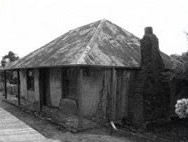 |
||||||||
Paintings, photomontages and assemblages
CLICK ON THUMBNAIL FOR TITLE & INFO
This body of work was made in response to the former gold rush town of Hill End, New South Wales, Australia during a four-week residency in 2011 organised by Bathurst Regional Art Gallery.
Sites of change have been central to Jones's recent practice: demolition sites, dried-up river beds, deconstructed architecture. Flux, erasure, deconstruction and renewal all play a part in the resulting paintings, prints and assemblages. Jones' interest in ideas of the "unmonumental" made the former gold-rush town of Hill End an apposite focus for these preoccupations presenting, as it does, vestiges of both simple living and historical, social and cultural flux.
Hill End is now a remote town of around 100 people but in the 19th. century it became one of the largest and busiest inland towns in Australia due to a rapid expansion following significant gold finds there in the 1850's. At its height the town had 8,000 inhabitants and serviced over twice that number in the surrounding district. It had a mile of shops and businesses and attracted prospectors from around the world including a sizeable number of Chinese. As the gold ran out, from the late 1870's onwards, Hill End rapidly declined to what was almost a ghost town until it can be said to have been "rediscovered" in the late 1940's by a group of eminent Australian artists. These artists, particularly the so called "venacular modernists" Russell Drysdale and Donald Friend, made work in Hill End in the 1940's & 50's that, by virtue of its reappraisal of the Australian landscape, was to have a significant influence on the development of Australian painting.
In Hill End, now a designated historic site, evidence of the gold rush era is seen in the architectural remains of simple tin-roofed cottages, empty plots on which once stood hundreds of such dwellings and in redundant sites of mining activity along the area's creeks and gullies.
The accommodation provided for artists on the residency programme are two typical 19th. century miners' cottages. Jones stayed in Haefliger's cottage and studio which contains the furnishings and paintings of the artist Jean Bellette and her art critic husband Paul Haefliger. The couple bought the cottage in the early 1950's, added a studio onto the back of the property and made frequent painting visits to Hill End over the years, before settling on Majorca. They bequeathed the property to the state as an artist's retreat.
A selection of the paintings and collages made during the residence formed a solo exhibition, Between the Hour & the Age, at BRAG, Bathurst, Australia Jan-March 2013, and Jean Bellette Gallery, Hill End, June-July 2013.
